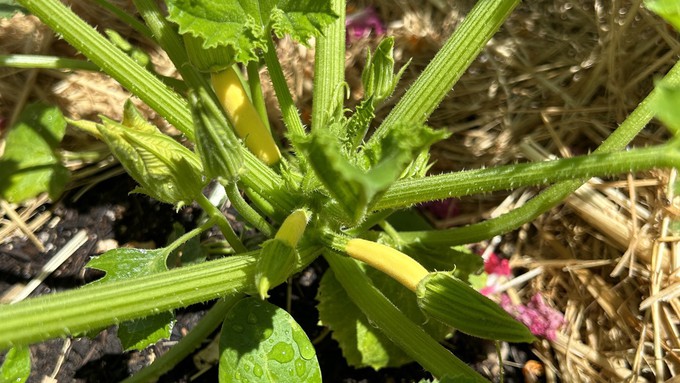
Coolish June weather continues but watch out for threat of thunderstorms

The squash is forming! But those babies won't grow unless pollinated. If bees aren't finding your zucchini flowers, try transferring pollen from the large flowers to the ones with mini squashes at the base. Use a small soft brush. Kathy Morrison
“When thunder roars, go indoors!” That’s the warning from the National Weather Service as unsettled weather conditions – including possible thunderstorms – continue this week.
According to the forecast, thunderstorms are possible this weekend in the Sierra and foothills, and maybe even the valley. Lightning can strike from up to 10 miles away, adds the weather service. Among the activities people who were recently struck by lightning were doing when they were hit: Gardening!
So, wait until storm clouds pass before you swing into action outdoors this week.
Meanwhile, our coolish June continues – at least a few more days. So far, only two days this month have been above Sacramento’s average June high temperature of 87 degrees. This week starts the same, dipping down to 77 on Monday under mostly cloudy skies.
By next weekend, we’ll see the mercury creep up to more normal summer-like conditions but not too hot. The expected high for Father’s Day (June 18): 89 degrees.
Make the most of these temperate conditions. (Just make sure to go inside if you hear thunder!)
* From seed, plant corn, pumpkins, radishes, melons, squash and sunflowers.
* Plant basil to go with your tomatoes.
* Transplant summer annuals such as petunias, marigolds and zinnias.
* It’s also a good time to transplant perennial flowers including astilbe, columbine, coneflowers, coreopsis, dahlias, rudbeckia, salvia and verbena.
* Tie up vines and stake tall plants such as gladiolus and lilies. That gives their heavy flowers some support.
* Dig and divide crowded bulbs after the tops have died down.
* Feed summer flowers with a slow-release fertilizer.
* Mulch, mulch, mulch! This “blanket” keeps moisture in the soil longer and helps your plants cope during summer weather.
* Thin grapes on the vine for bigger, better clusters later this summer.
* Cut back fruit-bearing canes on berries.
* Deep-water tomatoes, then feed with a balanced fertilizer. Bone meal can spur the bloom cycle and help set fruit.
* Generally, tomatoes need deep watering two to three times a week, but don't let them dry out completely. That can encourage blossom-end rot
* Feed camellias, azaleas and other acid-loving plants. Mulch to conserve moisture and reduce heat stress.
* Cut back Shasta daisies after flowering to encourage a second bloom in the fall.
* Trim off dead flowers from rose bushes to keep them blooming through the summer.
* Pinch back chrysanthemums for bushier plants with many more flowers in September.
Comments
0 comments have been posted.Sacramento Digs Gardening to your inbox.
Sites We Like
Garden Checklist for week of April 21
This week there’s plenty to keep gardeners busy. With no rain in the immediate forecast, remember to irrigate any new transplants.
* Weed, weed, weed! Get them before they flower and go to seed.
* April is the last chance to plant citrus trees such as dwarf orange, lemon and kumquat. These trees also look good in landscaping and provide fresh fruit in winter.
* Smell orange blossoms? Feed citrus trees with a low dose of balanced fertilizer (such as 10-10-10) during bloom to help set fruit. Keep an eye out for ants.
* Apply slow-release fertilizer to the lawn.
* Thoroughly clean debris from the bottom of outdoor ponds or fountains.
* Spring brings a flush of rapid growth, and that means your garden is really hungry. Feed shrubs and trees with a slow-release fertilizer. Or mulch with a 1-inch layer of compost.
* Azaleas and camellias looking a little yellow? If leaves are turning yellow between the veins, give them a boost with chelated iron.
* Trim dead flowers but not leaves from spring-flowering bulbs such as daffodils and tulips. Those leaves gather energy to create next year's flowers. Also, give the bulbs a fertilizer boost after bloom.
* Pinch chrysanthemums back to 12 inches for fall flowers. Cut old stems to the ground.
* Mulch around plants to conserve moisture and control weeds.
* From seed, plant beans, beets, cantaloupes, carrots, corn, cucumbers, melons, radishes and squash.
* Plant onion sets.
* In the flower garden, plant seeds for asters, cosmos, celosia, marigolds, salvia, sunflowers and zinnias.
* Transplant petunias, zinnias, geraniums and other summer bloomers.
* Plant perennials and dahlia tubers for summer bloom.
* Mid to late April is about the last chance to plant summer bulbs, such as gladiolus and tuberous begonias.
* Transplant lettuce seedlings. Choose varieties that mature quickly such as loose leaf.